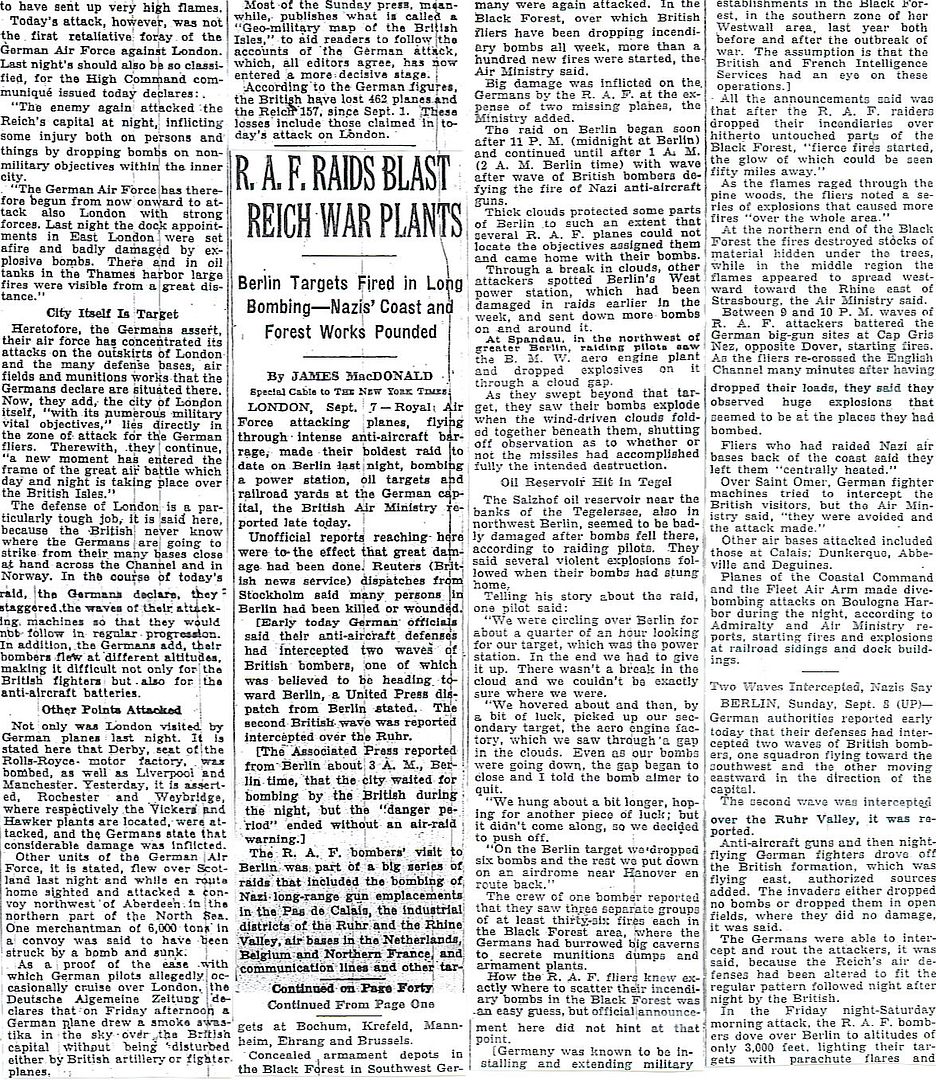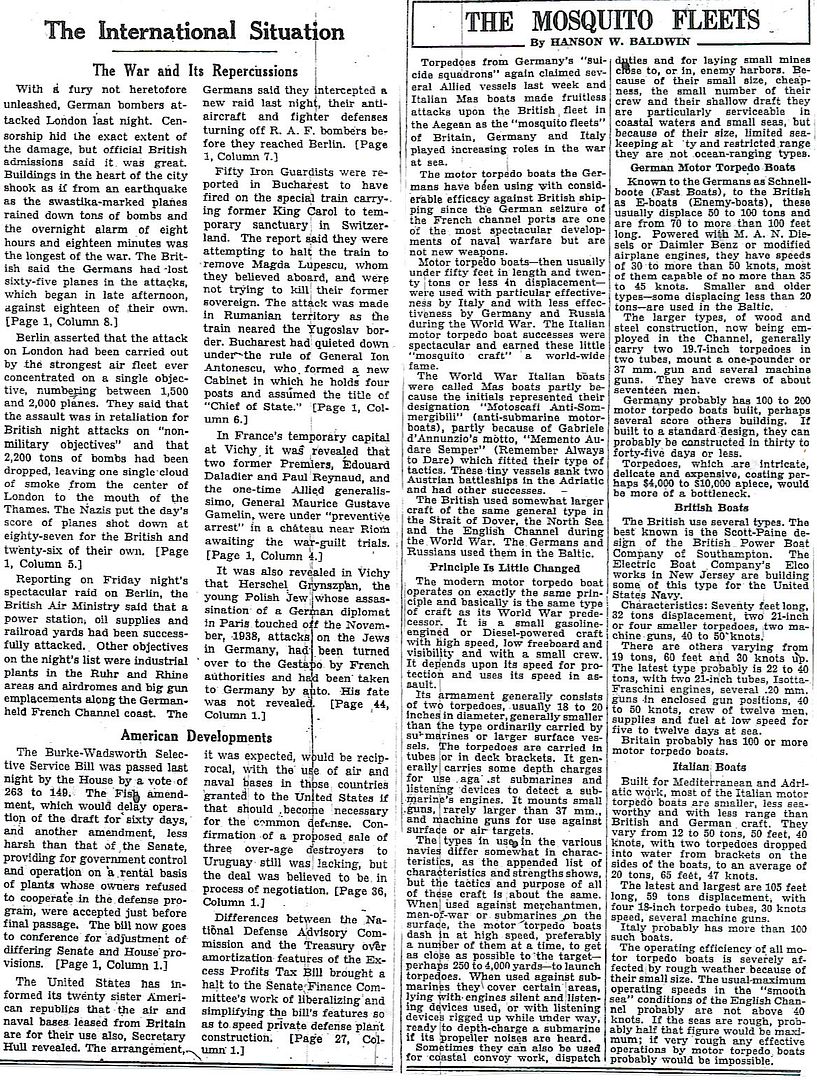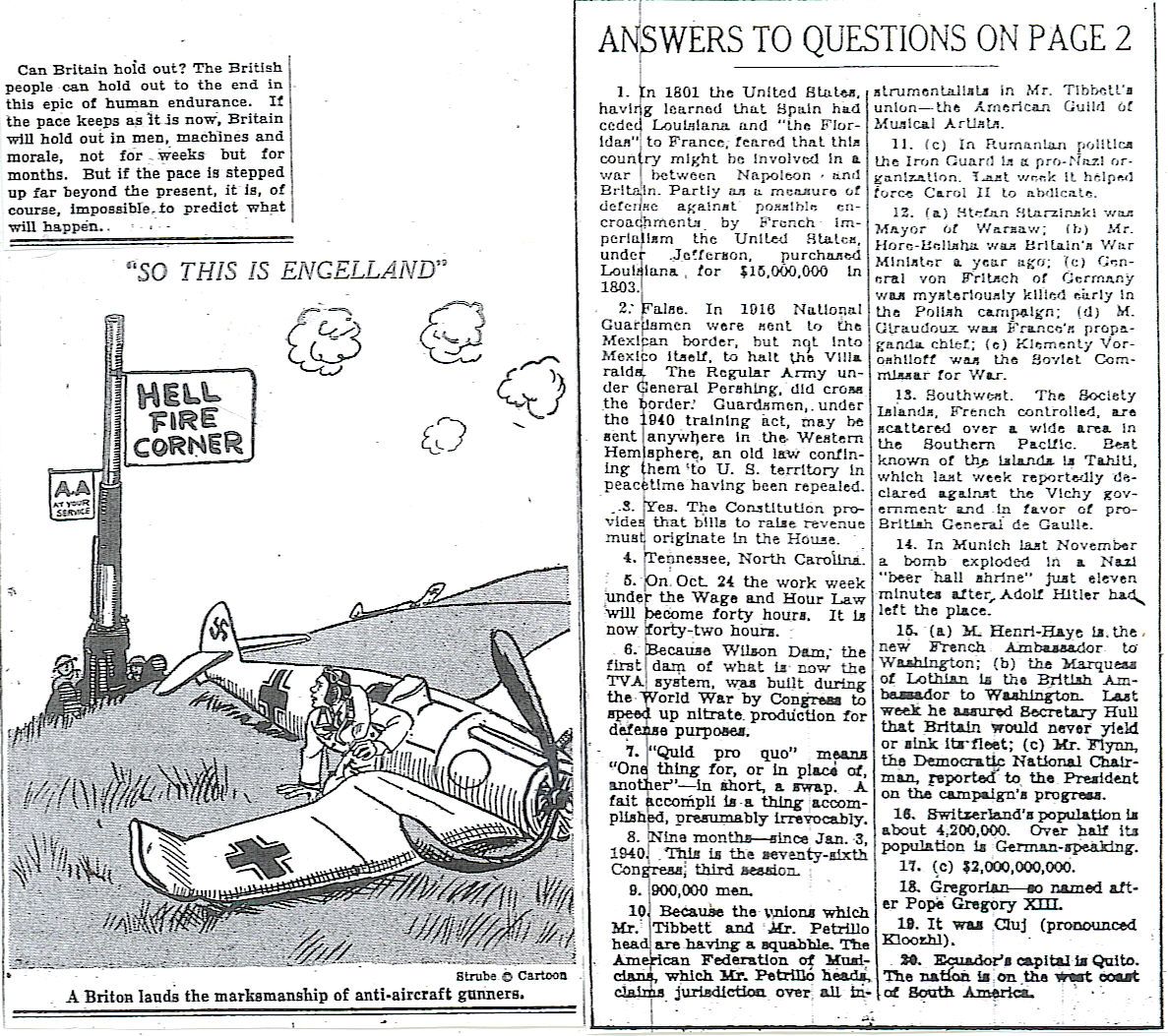
Posted on 09/08/2010 5:01:11 AM PDT by Homer_J_Simpson













Plus a special guest map from Michael Korda’s, “With Wings Like Eagles,” showing the air defenses of England and Wales, August 1940.
The News of the Week in Review
Twenty News Questions – 10
Mr. Low’s Painting of the Skies over London – 11
War’s Key Question: ‘Can Britain Hold Out?’ – 12-13
Answers to Twenty News Questions - 13
“’Burning copies of Mein Kampf same as bombing London,’ Obammie the Commie declares.
Date: 8th September 1940

Enemy action by day
Two attacks were made against the South East of England, the first by some 100 aircraft, mainly on the Kentish Coastal districts with a sub-section to Central London; the second by some 30 aircraft which penetrated to the London area and was a prelude to the night attacks in this district.
Some 16 reconnaissance flights were reported round the coast between Kinnaird's Head and Start Point, few of which penetrated inland.
During engagements with the enemy, our fighters destroyed 4 enemy aircraft (plus 3 probable and 8 damaged), and Anti-Aircraft accounted for three. Our casualties amounted to 4 aircraft of which 2 pilots killed or missing.
North
At 1300 hours a raid appeared 30 miles South East of Kinnaird's Head, flew South and faded North East of the Wash.
East
A few reconnaissance flights were made off East Anglia and the Estuary. One raid at 20,000 feet flew along the coast between Sunderland and Flamboro' but fighters failed to intercept. Two other reconnaissance flights of the Wash and Flamboro' were made.
South East
After two high flying reconnaissance flights of South London and the Thames Estuary in the early morning, there was little activity until 1105. At this time a sustained attack during which some 100 aircraft crossed the coast, commenced on objectives in Kent. At first the raids remained in the Coastal district from the North Foreland to Rye but were later plotted northwards over Kent to Sheppey and the Estuary. Two splits of a raid of 20+ aircraft headed towards London area. At 1311 hours the enemy began to withdraw.
The second attack was on a smaller scale, and commencing at 1930 hours, was directed to the London area. It appeared to be the prelude to the night operations; some 30 aircraft were involved and crossed the Coast between Beachy Head and Shoreham. This was followed by two reconnaissance raids, one of which penetrated Northwards to Bedford and the other to Hornchurch and Biggin Hill.
South and South West
Activity in this area was limited to a small number of reconnaissance flights off Start Point, Portland, and Isle of Wight and Beachy Head.
By night
Enemy raids continued to penetrate the London area from dusk onwards in a steady stream, originating from Cherbourg. There were continuously about 5 raids in this area. There was a lull about 0100 hours, but by 0200 hours activity had increased, there being about 20 raids in the South Eastern counties, including the London area, also several approaching the cost. These later raids appeared to be originating from Cherbourg and Dieppe.
One enemy aircraft is reported to have been shot down by Erith Guns at about 2100 hours, but not yet confirmed.
Balloons have been reported shot down, one mile South East of Hyde Park and at Wandsworth. Gun Sites reported attacked at Dulwich and Wanstead. Very little activity over the remainder of the country. Two raids in the Liverpool area, one to the Humber, and one over the Thames Estuary and out over Lowestoft.
Enemy activity continued later than usual up to 0500 hours. Later raids appeared to concentrate on East London and the Inner Thames Estuary and then flew Eastwards on their homeward course.

________________________________________
Statistics
Fighter Command Serviceable Aircraft as at 0900 hours, 8th September 1940
Casualties:
| Enemy Losses | ||
| By Fighters | ||
| Destroyed | Probable | Damaged |
| 3 Me109 | 1 Me109 | 3 Me109 |
| 1 Me110 | ||
| 1 Do215 | 2 Do215 | 4 Do215 |
| 4 | 3 | 8 |
| By Anti-Aircraft | ||
| Destroyed | Probable | Damaged |
| 3 Do215 | ||
| 3 | 0 | 0 |
Patrols:
Balloons:
Aerodromes:
Organisation:
Home Security Reports
http://www.onwar.com/chrono/1940/sep40/f08sep40.htm
Experienced squadrons keep best pilots
Sunday, September 8, 1940 www.onwar.com
From London... Dowding decides that the Fighter Command units in southeast England should have the right to select the best pilots to keep their experienced squadrons up to strength despite the effects this will have on the other parts of the Command and on planning for the future.
http://homepage.ntlworld.com/andrew.etherington/month/thismonth/08.htm
September 8th, 1940
UNITED KINGDOM:
Battle of Britain:
RAF Fighter Command: Lull by day. London bombed heavily by night. Dowding’s Squadron Stabilisation Scheme introduced.
Daylight brings two attacks on south-east England.
On the first, one formation attacked the coastal area North Foreland-Rye in an invasion softening up raid, while small numbers made for Sheppey or the London area.
Not until 19:30 was the next raid mounted, by about 30 aircraft which crossed Beachy to London, while reconnaissance’s were flown to Bedford and Hornchurch. By that time it seemed certain that London was going to suffer another night raid.
Around the 19:45 the first visitors of Luftlotte 3 were leaving the Le Havre area and an hour later steady streams were overflying Selsey and Shoreham and soon a continuous average of five raiders was over the IAZ until 05:00 - except for a brief lull around 01:00. Every Metropolitan borough and 60 local authority areas reported bomb damage, large fires overtaking Berger Paints in Homerton, Madame Tussauds and Baker Street. Three hospitals were hit, Fulham Power Station was set on fire and many bombs dropped indiscriminately fell close to the Thames. Major incidents occurred at Acton, Leyton, Poplar and at Broad Street Station. the Embankment was flooded at Chelsea.
412 people are killed and 747 injured.
Losses: Luftwaffe, 15; RAF, 2.
RAF Bomber Command: 4 Group Whitleys. 51 Sqn. 1 aircraft overshot on landing at Dishforth. Crew safe. 10 Sqn. 1 aircraft overshot Leeming on return from Ostend. aircraft burnt. 1 crew injured, rest safe. 58 Sqn. 1 aircraft undershot Linton-on-Ouse on operations. Crew safe.
Bombing - Dockyards at Bremen - invasion fleet at Ostend.
10 Sqn. Six aircraft to Ostend. Filthy weather, only one bombed. One crashed on return, crew safe.
58 Sqn. Three aircraft to Ostend. None bombed due to weather. Six aircraft to Bremen. One returned early, four bombed primary, one bombed an alternative.
77 Sqn. Two aircraft to Ostend. None bombed due to weather. Nine aircraft to Bremen. One returned early, seven bombed primary, one failed to bomb.
2 Group: Three crews of 82 Sqn. ordered to reconnoitre the Dutch harbours, one Blenheim returns, bombing Dunkirk on the way.
U.S.A.: Baseball, St. Louis Cardinals first baseman Johnny Mize hits home runs number 38, 39 and 40 in the first game of a doubleheader with the Pittsburgh Pirates and becomes the first player to hit 3 home runs in one game four times in his career. However, the Cardinals lose both games, 16-14 and 9-4. Mize finishes the season with 43 home runs and a .314 batting average for the third place Cardinals. (Jack McKillop)
http://worldwar2daybyday.blogspot.com/
Day 374 September 8, 1940
Battle of Britain Day 61. No. 11 Group commander AVM Keith Park flies his Hurricane over bomb-damaged parts of London, stating “It was burning all down the river. It was a horrid sight. But I looked down and said ‘Thank God for that’, because I knew that the Nazis had switched their attack from the fighter stations thinking that they were knocked out. They weren’t, but they were pretty groggy”. At noon, 20 Dornier bombers escorted by 30 Bf109s head for London but they are intercepted and turned back by RAF fighters (3 Dorniers and 1 Bf109 shot down). RAF loses 4 fighters shot down (2 pilots killed). At 7.30 PM, 30 aircraft drop incendiary bombs on London to provide markers for the night raids. Overnight, Thames Estuary and London’s East End are bombed again (3 more Dorniers shot down by antiaircraft guns). http://www.raf.mod.uk/bob1940/september8.html
British War Cabinet is convinced, by the heavy bombing of London the previous day and the accumulation of invasion barges on the Dutch and French coasts with favourable tides the next few nights, that invasion is imminent. Codeword “Cromwell” is passed to the Army and Home Forces, leading some to believe the invasion has started and causing great confusion. Church bells are rung, roadblocks set up, some bridges blown and landmines sown on some roads (killing 3 Guards officers). Home Guard units search beaches for invasion barges and scan the skies for approaching German paratroopers, but none come.
British cruiser HMS Aurora, escorted by 3 destroyers, shells German shipping and invasion barges in the harbour at Boulogne, France. British torpedo boats MTB-14, MTB-15 and MTB-17 sink a German ammunition ship off Ostend, Belgium.
Overnight in the Central Atlantic, 500 miles from the nearest land, German armed merchant cruiser Widder stops Greek collier Antonios Chandris (carrying 6,616 tons of coal from Cardiff to Buenos Aires). Widder’s Captain Ruckteschell orders the 29 crew to abandon ship in the lifeboats before Antonios Chandris is sunk by demolition charges at dawn. 22 crew will be rescued 31 days later on October 8, over 1400 miles away, by Portuguese freighter Serpa Pinto and landed at Rio de Janeiro, Brazil.
BBC - A Londoner on Shelters and the Blitz
(begin transcription)
…the air raid sirens went. We went to the shelter. We were a typical terraced house with the Anderson shelter, the bottom of a thirty yard garden and the next door shelter would be ten yards to the left and the other side would be ten yards to the right.
Now the old lady on our right refused to go down the shelter, she was almost blind and she was old and she said if she was going to die, she was going to die in her own house in her own bed. She just simply refused to use the shelter.
On the other side to the family, neighbors and friends, now this particular night there were a number of air raids and four land mines scuttled the road completely demolishing the whole of the road.
Now I distinctly remember being in the shelter, hearing a rush of wind followed by this noise that was the most deafening frightening noise I ever heard in my life, followed by a sensation of the whole of your body being compressed in. The air was pushed out and this hot sticky feeling in there. My father had been on the back wall outside of the house and the whole wall had collapsed on him and that was what saved his life. The shelter itself had crumpled and bent but basically had withstood the blast and we came out of the shelter and there was no street left, it was demolished.
The next door shelter with the family in appeared to be OK. It stood. And the other side, the house where the old lady lived, that had been completely demolished and there were some fires going on there.
My father rushed to the next door, the family and found them all to be dead. The blast had killed the whole family down there.
(end transcription)
Just looking at General Marcks’ plan for what will become Operation Barbarossa. Marcks was supposedly a brilliant planner, but there is a glaring deficiency in his plan. The final stopping point of the operation along the central axis is around Gorki. In one warm-weather campaign season, you can’t get there in the time allotted. Applying basic math to laws of logistics, it’s impossible.
Even the junior officers on his staff had to realize this.
Thank you for these pings Homer.
I look forward to them.
I’m not sure if today is the day the British win the BoB, but I’m pretty sure today is the day the Germans lose it.
I'm still deep into reading all the stuff Homer posted above. One of the meatiest and most interesting of all the great posts in his series!
Thanks to both of you.
Leni
My man Korda gives that distinction to the fifteenth. I will let him make his case next week and you can decide if he is right.
Thanks. That's our objective - to throw plenty of red meat to the voracious carnivores at Free Republic.
If there ever was a chance of Germany winning control of the air over Britain (which I can’t say I’m entirely convinced that is the case) this was the day that they made it impossible. I’ll be interested in reading Korda’s point of view on this next week.
Using just a general rule for mobile warfare, an advance can only go a maximum 250 miles before it has to over come its first logistic hurtles.
This plan, on the surface which consists of a move much further on a front line that is designed to expand as it moves out is clearly a logistical nightmare. I can’t imagine that no one saw this. I think it must have been decided that the Soviets would collapse long before they extended their front lines to these boundaries.
I just appreciate being able to contribute what little I do to this project. It’s a lot of fun and it really has help make me a better historian on the subject. I told the professor who is assisting me with my thesis that I read the paper from 70 years ago every morning and I think he was impressed that we are doing this. Either that or he thinks we are crazy which may have some merit to it.
Disclaimer: Opinions posted on Free Republic are those of the individual posters and do not necessarily represent the opinion of Free Republic or its management. All materials posted herein are protected by copyright law and the exemption for fair use of copyrighted works.